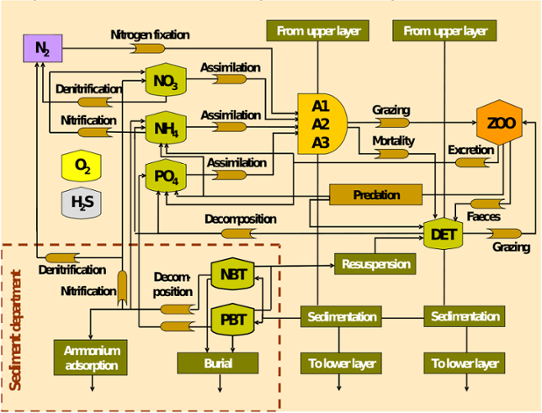The SCOBI model may provide information of for example:
- Nutrients, oxygen conditions and production of biomass.
- Fluxes, transports, sources and sinks.
- Water quality and sedimentation of organic matter.
- Development and spreading of algal blooms.
- Occurrence of harmful algal blooms (e.g. cyanobacteria).
SCOBI is used in combination with the PROBE model as a part of the Swedish decision support system. The combined model is called the Swedish Coastal zone Model (SCM) and delivers data to Vattenwebb annually.
SCOBI is one of the main components of an operational 3-D ecological model based on the ocean circulation model HIROMB coupled with atmospheric and hydrological models calculating the nutrient supplies from land and atmosphere.
SCOBI is also coupled to a high resolution 3-D ocean circulation climate model (Rossby Centre Ocean model, RCO). The aim is to perform experiments with a high spatial resolution ecological model on long time scales. The RCO-SCOBI model is used to study for example:
- the influence of climate changes on nutrient dynamics and biogeochemical cycles in the Baltic Sea.
- the influence of human activities on eutrophication related problems.
- transports of nutrients from sources to sinks
- the influence of natural events like deepwater inflows.

The SCOBI model handle dynamics of nitrogen- (N), oxygen- (O2) and phosphorus- (P), including inorganic nutrients, nitrate (NO3), ammonia (NH4) and phosphate (PO4) and particulate organic matter consisting of phytoplankton (autotrophs), dead organic matter detritus (DET) and zooplankton (ZOO). Primary production assimilates the inorganic nutrients by three functional groups of phytoplankton, diatoms (A1), flagellates and others (A2) and cyanobacteria (A3).
Besides the possibility to assimilate inorganic nutrients the modelled cyanobacteria also has the ability to fix molecular nitrogen (N2) which may constitute an external nitrogen source for the model system. Organic material may sink and accumulate in the model sediment as nitrogen (NBT) and phosphorus (PBT). In periods with strong currents and waves sediments in shallow areas may be lifted up into the overlying water again and become transported to deeper parts.
Decomposition of organic matter in the water and sediments consumes oxygen and may return the nutrients to inorganic forms (NH4 and PO4) again. When oxygen is almost completely consumed anoxic decomposition takes place. Anoxic decomposition processes utilize oxygen from nitrate reduction (denitrifikation) and thereafter from sulphate reduction (SO42-).
Sulphate reduction produces poisonous hydrogen sulphide (H2S) that is included as negative oxygen in the model and may be removed when oxygen is supplied e.g. by inflowing water. A fraction of the sediment nutrients are continuously buried while the nutrient flux to the overlying water is controlled by the water temperature and oxygen concentrations.
References
Edman, A., Sahlberg, J., Hjerdt, N., Marmefelt, E., Lundholm, K. 2007. HOME Vatten i Bottenvikens vattendistrikt. Integrerat modellsystem för vattenkvalitetsberäkningar. SMHI Oceanografi nr 89.
Eilola, K., and M. Meier, Implementation of a high-resolution 3D ecosystem model for local and regional climate studies in the Baltic Sea. BALTEX Newsletter No:9. GKSS, Geestacht, Germany, 2006.
Eilola, K., and J., Sahlberg, Model assessment of the predicted environmental consequences for OSPAR problem areas following nutrient reductions, SMHI Reports Oceanography No.83, 2006.
Eilola, K., Almroth, E., J. Naustvoll, P. Andersen and B. Karlson, Modelling the dynamics of harmful blooms of Chattonella sp. in the Skagerrak and the Kattegat, ICES CM 2006/E12, ICES Annual Science conference., 2006
Eilola, K., H.E.M. Meier, E. Almroth and A. Höglund, Transports and budgets of oxygen and phosphorus in the Baltic Sea, SMHI Reports Oceanography No.96, 2008.
Eilola, K., H.E.M. Meier and E. Almroth, On the dynamics of oxygen, phosphorus and cyanobacteria in the Baltic Sea; A model study. J. Mar. Sys., 75, 163-184, 2009.
Hjerdt, N., Sahlberg, J., Marmefelt, E., Lundholm, K. 2007. HOME Vatten i Bottenhavets vattendistrikt. Integrerat modellsystem för vattenkvalitetsberäkningar. SMHI Oceanografi nr 90.
Marmefelt, E., B. Arheimer, and J. Langner, An integrated biochemical model system for the Baltic Sea. Hydrobiologia, 393, 45-56, 1999.
Marmefelt, E., B. Håkansson, A.C. Erichsen, and I. Sehested Hansen, Development of an ecological model system for the Kattegat and the southern Baltic. SMHI Reports Oceanography No.29, 2000.
Marmefelt, E. och Olsson, H. 2005. Integrerat Kustzonssystem för Hallandskusten. SMHI Oceanografi nr 80. (http://www.smhi.se/sgn0106/if/biblioteket/rapporter_pdf/oceanografi-80.pdf)
Marmefelt, E., H. Olsson, H. Lindow and J. Svensson, Integrerat kustzonssystem för Bohusläns skärgård, SMHI Reports Oceanography, No. 76, 81 pp, 2004.
Marmefelt, E., Sahlberg, J. and Bergstrand, M. (2007). HOME vatten i södra Östersjöns vattendistrikt. Integrerat modellsystem för vattenkvalitetsberäkningar. SMHI oceanografi Nr.87.
Olsson, H. & Årnfelt, E. 2003. Kustzonsmodellen i regional miljöanalys. SMHI Oceanografi nr 74. 2003.
Sahlberg, J. and Olsson, H., 2001. Kustzonsmodell för norra delarna av Östergötlands skärgård. SMHI oceanografi. Nr 69, 2001.
Sahlberg, J. and Olburs, C. 2006. Vattenparametrar i anslutning till Kvädö fiskskötselområde FSO. SMHI rapport Nr. 2006-19.
Sahlberg, J., Marmefelt, E., Brandt M., Hjerdt, N., Lundholm, K. 2008. HOME Vatten i norra Östersjöns vattendistrikt. Integrerat modellsystem för vattenkvalitetsberäkningar. SMHI Oceanografi nr 93.
Svensson, U. 1998. PROBE An Instruction Manual. SMHI Rapport Oceanografi (RO) nr 24.